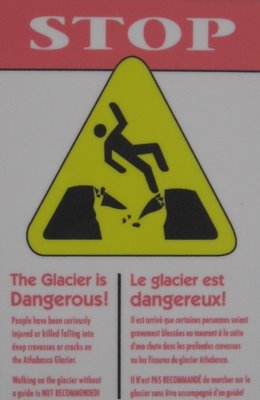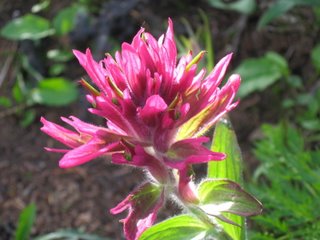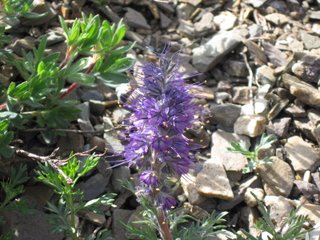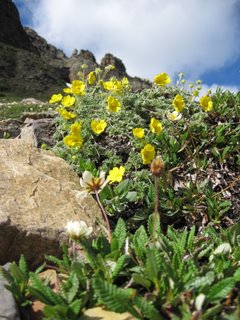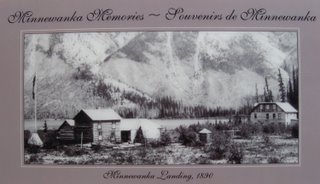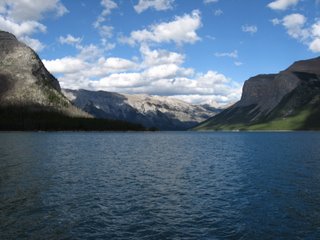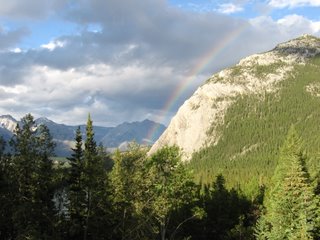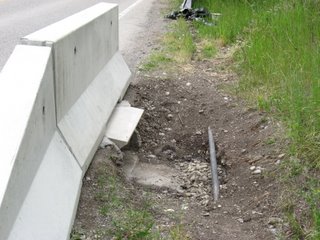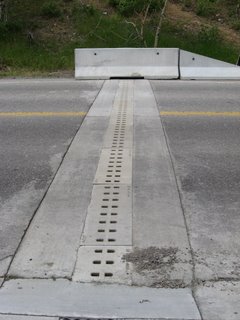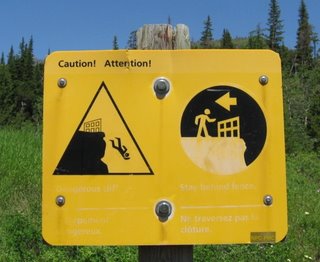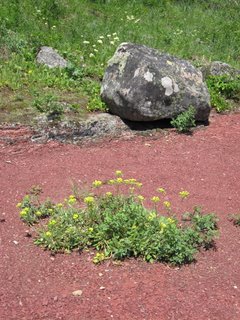
|
 |
 |
 |
 |
|
|
Friday, August 29, 2008Don't Walk Out Onto The Glacier Thursday, August 28, 2008
We drove up the Icefields Parkway into Jasper National Park, a very wild and woolly place of mountains, glaciers and stunning vistas.
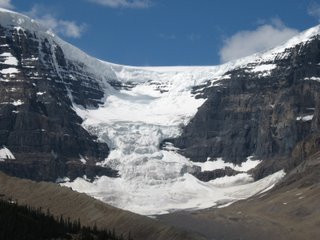 I've long wanted to camp at the Icefield itself, and this time I did so, pitching the tent near the Athabasca Glacier, which spills dramatically off the Icefield. Great grey clouds built up into storms over the Icefield, then funneled down across the glaciers to our tent. I've long wanted to camp at the Icefield itself, and this time I did so, pitching the tent near the Athabasca Glacier, which spills dramatically off the Icefield. Great grey clouds built up into storms over the Icefield, then funneled down across the glaciers to our tent.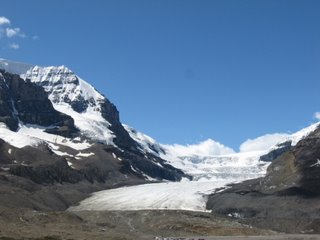 When I was four, my parents took me out onto the Athabasca Glacier in a little snow cat. I vividly remember the driver stopping the cat, swinging open the door over a huge blue-black yawning chasm and saying, "Take a look at that crevasse!" When I was four, my parents took me out onto the Athabasca Glacier in a little snow cat. I vividly remember the driver stopping the cat, swinging open the door over a huge blue-black yawning chasm and saying, "Take a look at that crevasse!"It was the coolest thing EVER. In the photo below, the little vehicle on top is what we took out onto the glacier. Now they use the big snow coach pictured below it. 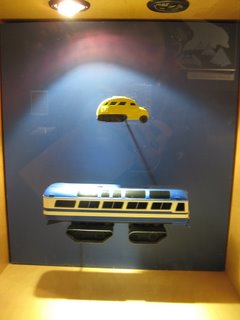 posted 3:16 AM
Tuesday, August 26, 2008
...of Banff National Park is missing its third toe. Because glaciers have been receding since the late 1800s, this glacier has changed shape since it was named.
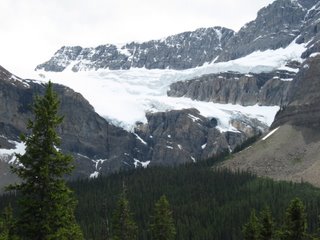 This photo was taken in 1918, and shows the third toe. This photo was taken in 1918, and shows the third toe.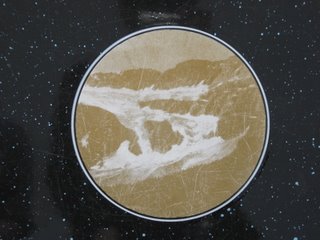 posted 8:51 PM
Friday, August 22, 2008
The tenting section of the Lake Louise campground in Banff National Park now has an electric fence surrounding it. The decision to try such a fence was made after repeated people/bear encounters that did not go well.
 Many visitors to national parks (in both Canada and America) don't take the "Don't Feed The Wildlife" signs seriously. Some mean well, thinking the bears or other wildlife must be starving. Others feed wildlife to get close enough to get a photograph. But most just don't think about it. People feed wildlife directly and even indirectly, by leaving a dirty campsite with coolers, stoves, and dirty dishes strewn about. The odors attract the bears, who tear into the coolers or eat food scraps or anything with a smell, including toothpaste and other toiletries. Bears are incredibly smart. Even if the cooler is empty, through experience they know it's a food storage device and will tear into it anyway. Many visitors to national parks (in both Canada and America) don't take the "Don't Feed The Wildlife" signs seriously. Some mean well, thinking the bears or other wildlife must be starving. Others feed wildlife to get close enough to get a photograph. But most just don't think about it. People feed wildlife directly and even indirectly, by leaving a dirty campsite with coolers, stoves, and dirty dishes strewn about. The odors attract the bears, who tear into the coolers or eat food scraps or anything with a smell, including toothpaste and other toiletries. Bears are incredibly smart. Even if the cooler is empty, through experience they know it's a food storage device and will tear into it anyway.This habituation of wildlife has many bad consequences. Human food is disastrously unhealthy for wildlife, and can weaken their systems, leading to malnutrition and death. Bears get used to being around humans. They get hit on the road after being repeatedly fed out of car windows. And when they start seeing humans as a food source, that is when dangerous encounters happen. People get too close to the bears, the bears get agitated, and people (and bears) get hurt. Bears who repeatedly return to human-populated areas searching for food and garbage become "problem bears," and are relocated. If they keep coming back, the bears are killed. So people who think they are doing the bear (or other wildlife) a favor, couldn't be more wrong. The park service has a saying: "A fed bear is a dead bear." To cut down on these incidents, Parks Canada constructed an electrical fence around the tenting section of the Lake Louise Campground. Humans can pass through pedestrian gates, but they are hoping it will keep bears out, and thus protect them from humans who are inadvertently destroying them. 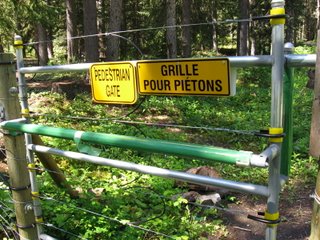 posted 12:49 PM
Wednesday, August 20, 2008
I'm excited to officially announce that Penguin will be publishing my novel Voracious in February!
Set in the wilds of Glacier National Park, Voracious is my tribute to the amazing mountainous places I've been to, as well as a tale of terror and suspense. I hope you'll check it out! Here is the cover:  posted 11:16 AM
Tuesday, August 19, 2008
In an effort to cut down on the mortality rate of animals who are hit by cars, Banff National Park has constructed a number of wildlife overpasses and underpasses. In the photo below, note the trees growing on the overpass. Bears, elk, deer, wolves, cougars and more use these passages to safely cross the TransCanada Highway, which bisects the park.
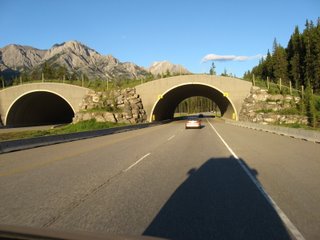 At both the under and overpasses, wires have been strung across the entryways. When bears and other animals climb over or under these wires, pieces of their hair get snagged. Biologists have been using this method of DNA sampling to figure out exactly which animals are using the passes. The study is ongoing, but so far mortality rates have been reduced considerably, including 80% less bear mortalities. At both the under and overpasses, wires have been strung across the entryways. When bears and other animals climb over or under these wires, pieces of their hair get snagged. Biologists have been using this method of DNA sampling to figure out exactly which animals are using the passes. The study is ongoing, but so far mortality rates have been reduced considerably, including 80% less bear mortalities.posted 6:52 PM
Monday, August 18, 2008Sunday, August 17, 2008
The hike up to Eiffel Lake in Banff National Park is my favorite alpine hike I've gone on yet. I went a few years ago, thrilling to the views of rock, ice and incredible wildflowers. Each time I've returned here, though, the hike has been closed because of a grizzly in the area who was raising cubs.
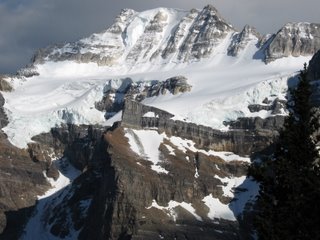 This year, however, she hadn't started using that area yet, so the trail was still open. I was ecstatic! This year, however, she hadn't started using that area yet, so the trail was still open. I was ecstatic! It leaves from gorgeous Moraine Lake and climbs high into the alpine zone, above the treeline. As before, the wildflowers covered the slopes in a myriad of colors, pink and red Indian Paintbrush, pale white Pasque flower, yellows, purples and blues extending in all directions. It leaves from gorgeous Moraine Lake and climbs high into the alpine zone, above the treeline. As before, the wildflowers covered the slopes in a myriad of colors, pink and red Indian Paintbrush, pale white Pasque flower, yellows, purples and blues extending in all directions.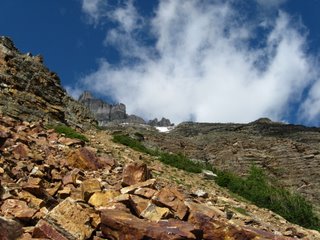 The trail journeys into the Valley of 10 Peaks, named after the immense mountains that rise on one side of the trail. Glaciers cling to their precipitous slopes. As we climbed, Moraine Lake grew smaller and smaller, until it was just a blue jewel gleaming far below. The trail journeys into the Valley of 10 Peaks, named after the immense mountains that rise on one side of the trail. Glaciers cling to their precipitous slopes. As we climbed, Moraine Lake grew smaller and smaller, until it was just a blue jewel gleaming far below.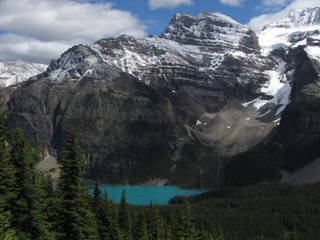 We crossed a few snowfields, looking for prints of wolverines. We crossed a few snowfields, looking for prints of wolverines.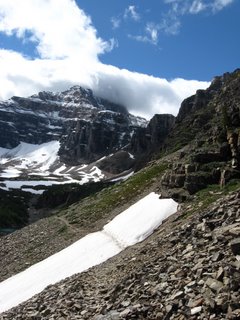 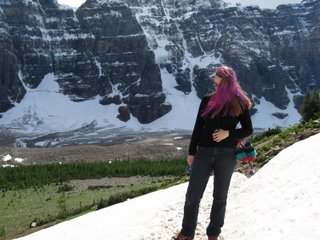 I didn't see any wolverines, but hoary marmots came out to check me out, peering from their rock perches and sometimes coming down to the trail to stare. We reached Eiffel Lake as a storm started brewing over the mountains. Fresh snow still covered the area from the snowfall the night before. I didn't see any wolverines, but hoary marmots came out to check me out, peering from their rock perches and sometimes coming down to the trail to stare. We reached Eiffel Lake as a storm started brewing over the mountains. Fresh snow still covered the area from the snowfall the night before.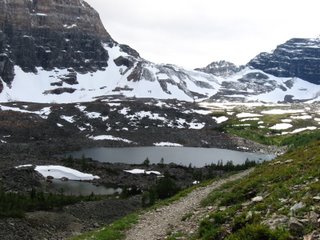 The views from the alpine are simply stunning. We could see all of the Ten Peaks, and the rock and dirt-covered Wenkchemna Glacier stretched out far below us. The views from the alpine are simply stunning. We could see all of the Ten Peaks, and the rock and dirt-covered Wenkchemna Glacier stretched out far below us.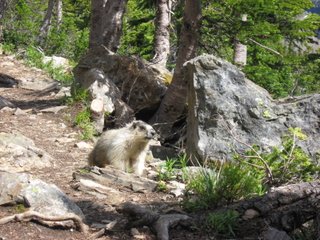 posted 12:47 PM
Friday, August 15, 2008
We hiked in Kootenay National Park, another gorgeous park bordering Banff. I revisited a favorite hike, Marble Canyon. This section of the park had burned since my last visit, and the vista was staggeringly different.
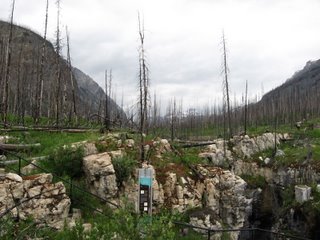 A narrow canyon plummeting to a roaring white water river, Marble Canyon offers some fantastic view points. A narrow canyon plummeting to a roaring white water river, Marble Canyon offers some fantastic view points.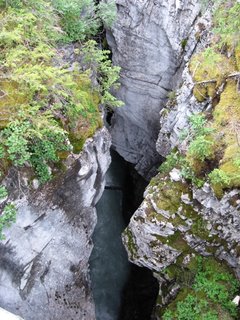 The trail winds up the length of the canyon, starting where the water pours out and ending at the waterfall that plummets into the start of the canyon. The trail winds up the length of the canyon, starting where the water pours out and ending at the waterfall that plummets into the start of the canyon.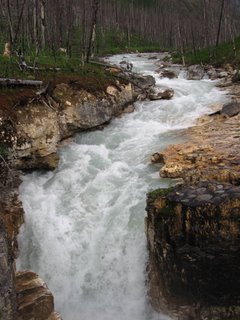 One of my favorite birds was hunting along the water's edge -- the American Dipper. This amazing bird will dive into freezing whitewater and actually walk around on the bottom, then leap back onto the river's edge, flapping its wings. Then it waits, bobbing up and down, looking for morsels in the water. It's unbelievable what they'll jump into, broiling water that looks like it will smash them against the rocks in an instant. But it doesn't. They're in and out with amazing speed. It was nesting in the canyon, and flew down into the cool of the dark recess with its food. One of my favorite birds was hunting along the water's edge -- the American Dipper. This amazing bird will dive into freezing whitewater and actually walk around on the bottom, then leap back onto the river's edge, flapping its wings. Then it waits, bobbing up and down, looking for morsels in the water. It's unbelievable what they'll jump into, broiling water that looks like it will smash them against the rocks in an instant. But it doesn't. They're in and out with amazing speed. It was nesting in the canyon, and flew down into the cool of the dark recess with its food.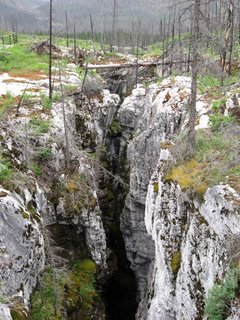 posted 12:43 PM
Thursday, August 14, 2008
We took a side trip into neighboring Yoho National Park, to the site where the Burgess Shale Fauna were discovered in 1907 by Charles Walcott. The area had been reknown since 1886 as a hotbed for trilobite fossils, but Walcott found something else amazing. In a stretch of rock called the Burgess Shale, he found the fossilized remains of strange and glorious creatures which lived 515 million years ago.
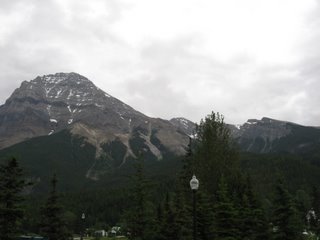 Usually when a creature is fossilized, only the hard parts like bones are preserved. But the amazing animals in the Burgess Shale show all their soft parts -- eyes, mouths, legs, and other strange appendages at a time before bones had even evolved. Some of the creatures included Anomalocaris, a two-foot carnivorous shrimp-like creature, and Hallucinagenia, an animal made up of tentacles and spikes which it walked upon. Usually when a creature is fossilized, only the hard parts like bones are preserved. But the amazing animals in the Burgess Shale show all their soft parts -- eyes, mouths, legs, and other strange appendages at a time before bones had even evolved. Some of the creatures included Anomalocaris, a two-foot carnivorous shrimp-like creature, and Hallucinagenia, an animal made up of tentacles and spikes which it walked upon.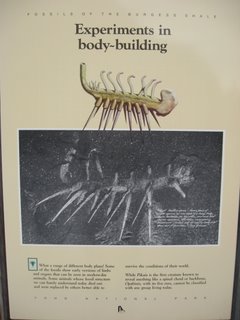 For more info on the Burgess Shale, check out Stephen J. Gould's book Wonderful Life. posted 3:10 PM
Wednesday, August 13, 2008
For the first time I ventured out to Lake Minnewanka in Banff National Park. A beach house had been built here in 1886, followed by a little town called Minnewanka Landing. It included hotels and restaurants, and offered boat tours of the lake.
But a series of dams has now completely inundated the town. 1941 saw the last of the surface existence of Minnewanka Landing. Now scuba divers are the only human visitors to the town's avenues and submerged structures. posted 12:30 PM
Monday, August 11, 2008
We drove through Calgary and on to Banff National Park, one my absolute favorite places. The mountain range here is stunning -- very jagged peaks and precipitous slopes, with thick blue glaciers hanging in the valleys. The Bow River roars through, teal and white, and churning.
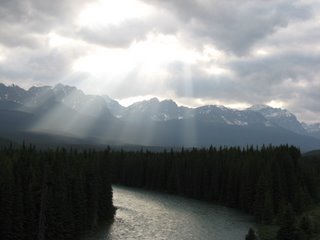 We walked around by the spooky and grand Banff Springs Hotel, one of the Canadian Pacific Railway hotels built in the nineteenth century. 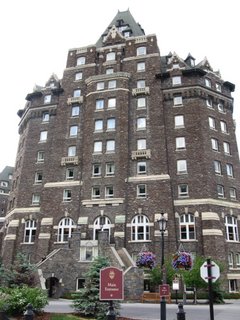 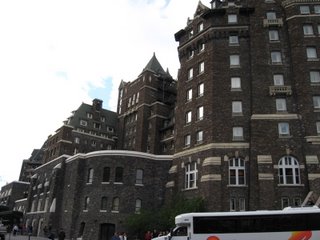 The national park here truly is a stunning place. We got a wooded site at Tunnel Mountain campground. At night, we listened to the call of a barred owl and saw a myriad of stars as one can only see in the darkness of a national park. The national park here truly is a stunning place. We got a wooded site at Tunnel Mountain campground. At night, we listened to the call of a barred owl and saw a myriad of stars as one can only see in the darkness of a national park.posted 10:15 PM
Saturday, August 09, 2008
We stopped for one more look at Waterton Lake.
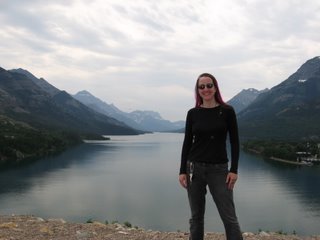 As we left Waterton Lakes National Park, a terrific storm raged over the mountains. The sky turned dark grey, with fantastic lightning snaking through the clouds. As we left Waterton Lakes National Park, a terrific storm raged over the mountains. The sky turned dark grey, with fantastic lightning snaking through the clouds.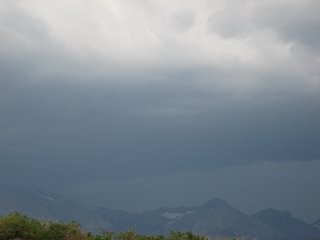 posted 11:16 PM
The threatened long-toed salamander faces a dangerous series of treks every year in Waterton Lakes National Park. They leave the safety of Linnet Lake, cross the main road in Waterton to lay eggs, then cross the road again to return to the lake. Then once the eggs hatch, those young salamanders must then cross the road, too. So many have been hit, that the population is in danger.
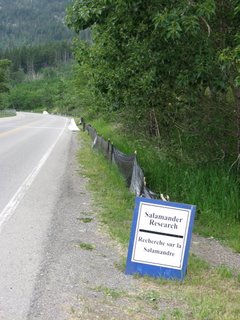 And so a clever plan was devised to save them. Sheeting was constructed on both sides of the road to direct the salamanders to special underpasses. This sheeting funnels them to openings and they then walk under the road, protected from the dangers of cars. And so a clever plan was devised to save them. Sheeting was constructed on both sides of the road to direct the salamanders to special underpasses. This sheeting funnels them to openings and they then walk under the road, protected from the dangers of cars.posted 1:39 AM
Wednesday, August 06, 2008Tuesday, August 05, 2008
In Waterton is a stunning redrock canyon, aptly named just that, Redrock Canyon. The teal river flowing through it cuts steeply, leaving gorgeous red and white streaked rock.
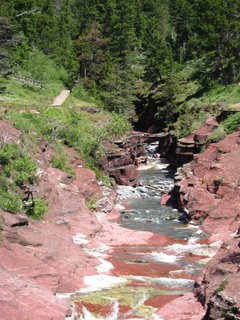 We walked down to the bottom at one point, putting our toes in the near freezing glacial runoff water. We walked down to the bottom at one point, putting our toes in the near freezing glacial runoff water.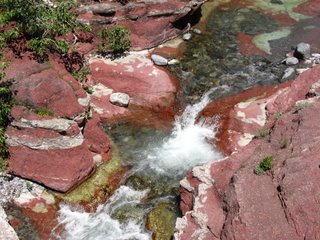 The soil is a deep red color, vivid against the green grass and wildflowers. Above, the deep mountain blue sky stood in stark contrast to the red of the rocks. A few billowing clouds drifted lazily across the azure expanse. The soil is a deep red color, vivid against the green grass and wildflowers. Above, the deep mountain blue sky stood in stark contrast to the red of the rocks. A few billowing clouds drifted lazily across the azure expanse.posted 11:00 PM
The wildflowers here grow in glorious abundance. Purple lupine, wild roses, red Indian paintbrush, golden brown-eyed Susans, white yarrow. It's simply stunning.
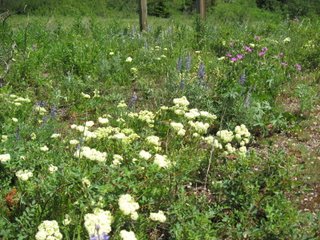 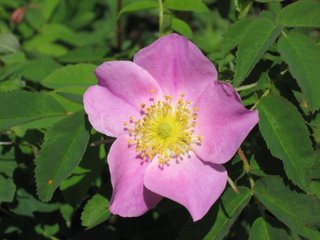 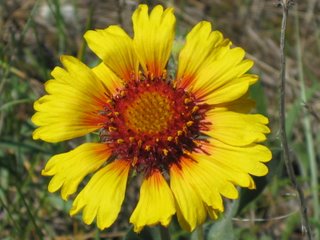 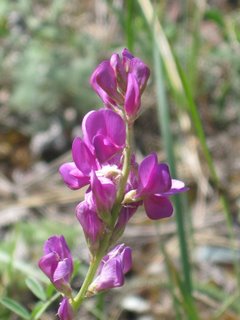 This is one of my favorite lichen-covered boulders. This is one of my favorite lichen-covered boulders.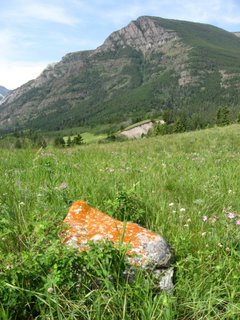 posted 12:41 AM
Sunday, August 03, 2008
From Glacier National Park, we crossed into Canada to Waterton Lakes National Park. Waterton Lake is a huge, gloriously blue lake surrounding by jagged peaks on three sides.
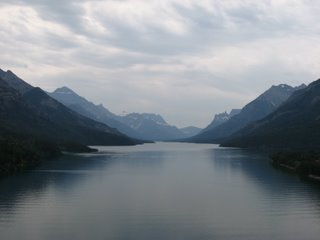 The Prince of Wales Hotel, one of the grand Canadian Pacific Railroad hotels, stands at the edge of a hill overlooking the lake. The Prince of Wales Hotel, one of the grand Canadian Pacific Railroad hotels, stands at the edge of a hill overlooking the lake. We camped in an amazing spot that overlooked the Blakiston Creek and mountain peaks on the opposite side. Waterton has been called "where the prairie meets the mountains," because the terrain changes from rolling, golden-grassed plains to striking snow-capped peaks. We camped in an amazing spot that overlooked the Blakiston Creek and mountain peaks on the opposite side. Waterton has been called "where the prairie meets the mountains," because the terrain changes from rolling, golden-grassed plains to striking snow-capped peaks.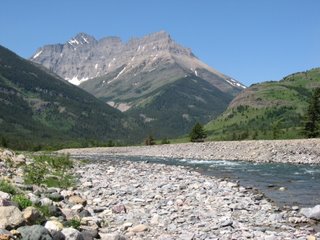 posted 9:44 PM
Friday, August 01, 2008
Logan's Pass, the highest point of the Going-To-The-Sun Road, was completely under snow. We walked on snowfields and gazed at the black and gray peaks around us.
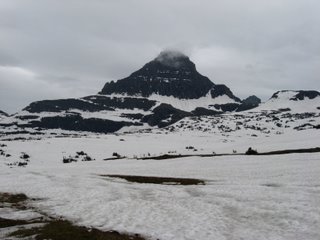  A few green shoots were starting to push up through the soil, but other than that, it was a land of snow, ice, and rock. A few green shoots were starting to push up through the soil, but other than that, it was a land of snow, ice, and rock.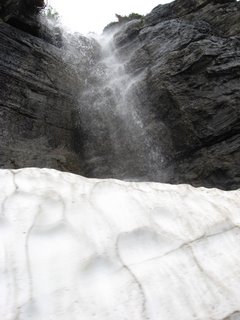 A bighorn sheep strolled by, navigating the scree slope above us. 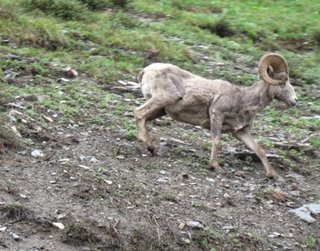 posted 3:25 PM
ArchivesApril 2005 May 2005 September 2005 November 2005 December 2005 March 2006 April 2006 May 2006 June 2006 August 2006 September 2006 October 2006 December 2006 January 2007 March 2007 April 2007 May 2007 June 2007 July 2007 August 2007 September 2007 November 2007 December 2007 January 2008 February 2008 March 2008 May 2008 June 2008 July 2008 August 2008 September 2008 October 2008 November 2008 December 2008 February 2009 March 2009 April 2009 May 2009 June 2009 July 2009 August 2009 September 2009 October 2009
|



